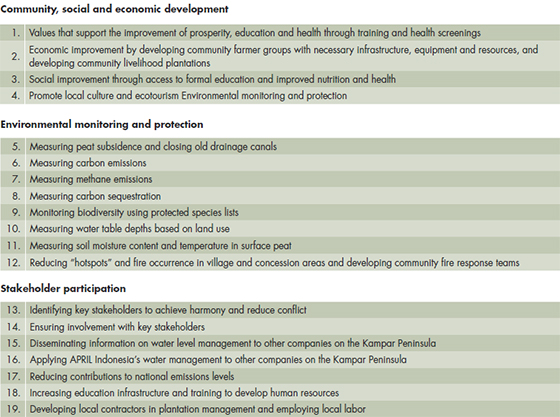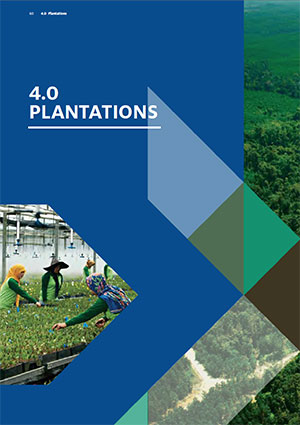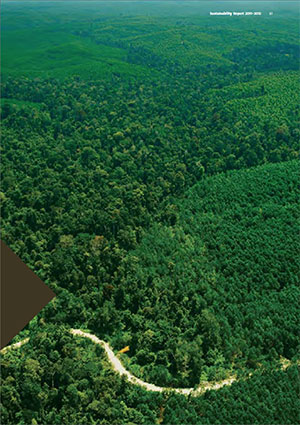Increased Monitoring, Reporting and Verification
In 2009, Indonesia’s Ministry of Forestry appointed an independent and integrated team of specialists to evaluate APRIL’s land-use planning and water management system on the Kampar Peninsula through a multi-year Monitoring, Reporting and Verification (MRV) process. The MRV teams have been active throughout the period of this report and have indicated that the work being undertaken with APRIL may, in time, become a model for other forestry sector participants.
The implementation of MRV is based on four key areas related to peatlands and the establishment of plantations on peatland:
- Community preparedness for changes in social and cultural values as a result of plantation development
- Communities’ ability and opportunity to benefit from plantation development
- Managing the impacts of peat water drainage on carbon emissions and impacts on protected natural forests
- Ability to sustainably manage water levels to reduce the likelihood of fires
Figure 46: KAMPAR PENINSULA MRV INDICATORS
MRV Assessment
APRIL’s operations in the Kampar Peninsula have been favorably rated in the Measurement, Reporting and Verification (MRV) assessments conducted by a team from Indonesia’s Ministry of Forestry. The MRV assessment occurred every six months over the reporting period. This involved report analysis, field visits, discussion and verification of indicators and the progress or constraints for 19 MRV indicators which covered production and social and environment issues including biodiversity.
APRIL cooperates fully with the MRV team. We provide access to all areas of our operations and actively participate in gathering and delivering data for analysis and verification.
The company has assisted in the formation of farmer’s groups, provided training on integrated farming systems, participated in the creation of savings and loans facilities for local communities and provided advice and resources for production from community farming areas. Such activities are monitored by the MRV team.
Key findings over the January-December 2012 period by the MRV team have included:
- APRIL’s contribution has helped meet important socio-economic and local culture indicators by maintaining the values that support the Human Development Index (HDI) through its community development programme. The programme supports the development of education, health, infrastructure, and agriculture for community welfare.
- APRIL has implemented a mutual cooperation programme with the community. This includes environmental clean-ups by employee volunteers, procurement of library books in villages (more than 3,640 books), a health education program and character building training for students. Most of the programs are above target.
- APRIL helped establish 19 farmer groups and set up four savings and credit units. In 2012, 101 community residents were trained in the use of the Integrated Farming System. The achievements are above target.
- Initial evaluations of progress in establishing rubber livelihood crops for local communities showed that progress was below target. But after APRIL followed and implemented the MRV team recommendations, rubber establishment has shown substantial progress, i.e. 4,040 hectares of rubber livelihood crops have been established. Initial constraints to completion of the livelihood crops programme included availability of high quality seeds, lack of trained manpower, delays due to weather and plant disease.
- For the last two years, activities for measuring and analysing environmental data, including hydrology (water management), carbon source and sink, peat subsidence, fire prevention, and biodiversity have been underway. Gathering of data on eco-hydro peat subsidence, watertable levels and carbon emissions have taken place across the main crop areas, local species areas and protected areas. The impact of closure of illegal drainage canals has also been monitored.
- Measurement of soil water (water table) has been carried out, initially being monitored manually each month and gradually transitioned to monitoring by sensors and data loggers. Soil water content and soil temperature measurement has been conducted in conjunction with CO2 measurement, and methane gas measurement has also been performed. Measurement methodologies have been progressively adjusted to reduce variability and improve accuracy.
- The management of carbon emissions and peat subsidence produced results that exceeded targets.
- Measurement of above ground biomass has been undertaken but no significant work has been done to measure below ground biomass such as biodiversity and respiration. Below ground observations will be considered.
- The result of biomass assessment shows that Acacia crassicarpa sequestrates more carbon than alternatives and stores it as biomass. However, studies continue to seek more certain conclusions and a specific allometric equation for the species. Measurement of biomass data will continue to be undertaken and data made public at a later stage. Biomass measurement in Estate Meranti has been regularly conducted over the 2 year period up to the end of 2012 (age classes 1 and 2). Therefore, biomass data from Estate Pelalawan will be able to be used as a reference for age classes 3 and 4 for Acacia crassicarpa.
- APRIL has measured and monitored biodiversity within its conservation areas and been recognized for this work. The MRV team has recommended APRIL grouping the species favored by communities, increasing the economic benefit for communities and comparing the results associated with non-timber species and species in conservation areas.

